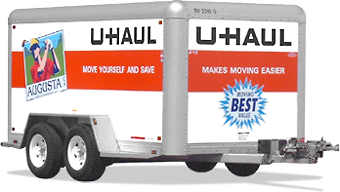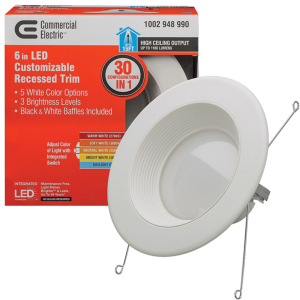My buddy Karl and I just made a trip to the new house, and because he has a Ford F250 Super Duty with a diesel engine, we rented the biggest trailer U-Haul has, which is a 6’x12’ enclosed cargo trailer. That’s about twice the cubic feet of the trailer I rented for my last trip, plus it has two axles and hydraulic brakes.
We found out that the trailer has can take a max load of only 2,480 pounds after we had already loaded it with more than 3,500 pounds of gear. Here’s some of what was in it:
- Another 30+ ammo cans. That’s got to be more than 750 pounds.
- 39 boxes that each held six #10 cans (about 950 pounds)
- 30 5-gallon pails and 6-gallon super pails of wheat, rice, beans, sugar, corn, oatmeal and some pasta. I figure that’s another 1,200 to 1500 pounds.
- Most of the traditional canned food from our prepper pantry.
- Boxes of tools, workshop items, gun-related gear, knives, plate carriers and other tactical gear, night vision, lanterns, candles, first aid supplies, gardening equipment, camping gear, water filters, and more miscellaneous prepping items.
- Three of the warehouse type metal shelves with particle board shelving.
When we noticed that the springs had compressed pretty far and the trailer had dropped a couple inches we decided that we were probably pushing our luck. That’s when we checked the max load and decided to stop loading, even though there was more room in the trailer.

I guess that in U-Haul’s defense, people are usually loading their trailers with household goods, like sofas, easy chairs and beds, things that are big a puffy and don’t weight as much as bullets or buckets of grain.
We had no doubt the truck could pull the load – it’s rated for 13,000 pounds towing capacity and the 2-inch ball was rated at 10,000 pounds. We knew the truck would be fine. But would the trailer?
I guess that in U-Haul’s defense, people are usually loading their trailers with household goods, like sofas, easy chairs and beds, things that are big a puffy and don’t weight as much as bullets or buckets of grain.
We had no doubt the truck could pull the load – it’s rated for 13,000 pounds towing capacity and the 2-inch ball was rated at 10,000 pounds. We knew the truck would be fine. But would the trailer?
Well, we had the insurance. We decided we’d just have to give it a shot. After all, I’m sure they give you a pretty good safety cushion, right? These are rentals, so they must give you a safety margin.
Why we Rented a Trailer
Now you might me wondering why I keep renting a trailer instead of hiring movers. For two reasons: Privacy and hazardous materials.
I’m moving scores of ammo cans. I don’t want to advertise the fact that I have an armory in my basement. Same with the food. The fewer people that know I have more than a ton of dehydrated food in my basement the better. Because you know that as soon as they get in the truck, the moving company guys will be talking about it. And then when they get home, they’ll be talking to their buddies. “Damn, this dude, he must have had 50,000 rounds of ammo and a big gun safe.” Nope, that room is going to be locked when they show up.
As for restrictions, there a long list of items that moving companies won’t move. Some of it makes sense, like gas cans and other hazardous materials. Some of it makes less sense, like aerosol bottles, cleansers such as bleach and ammonia, paint, anything in a pressurized container, and charcoal. And yes, ammunition, gunpowder and primers are on that list.
So that means we have to move stuff like that ourselves. If we were to do it one pickup truck bed at a time, it would take six months. So we’re renting trailers and the less U-Haul knows about what we put in them, the better.
The Road Trip
Karl usually trailers a good sized boat. He has much more experience than I do pulling a trailer, and it showed. No sitting in the slow lane and going the speed limit for him! Of course, his bigger engine helped. That truck could pull a fifth wheel or a huge camper, so the cargo trailer was no problem.
We stopped for lunch and checked the tires. They were not unduly hot. This is despite the fact that every U-Haul I’ve ever seen says they should be driven 55 MPH. Yeah, right. Who has ever done that? When did they come up with that rule? Back when Carter was president and he dropped the speed limit?
During lunch, we were the only people who ate inside the fast food joint. Everyone else used the drive-through window, even though the restaurant was open with two thirds of the booths and tables roped off. The drink machines were also roped off; I guess they didn’t want to clean them, or maybe there wasn’t enough traffic to justify filling them. I’m pretty sure there were only three employees in the place: A cook, the manager who worked the drive through window, and a teenage boy who did everything else.
We got back on the road, stopping only once more to fill up on diesel.
Our Remote Location
I think I have mentioned before that our new prepper property is well off the beaten path. In my opinion, this is one of the best things about it. In my wife’s opinion, we are a little more remote than she would like.
Karl thought it was great. As we drove out of town down the twisty-turny road, he was downright enthusiastic. If he had brought a fishing pole, I swear he would have stopped and tried a few fishing holes along the way. When we left the pavement and proceeded up the mountain with greenery encroaching on both sides, he was beside himself. He immediately recognized the benefits of living on a dead end road off the beaten path in terms of being far from trouble but also being in a position to defend yourself if it somehow managed to show up. I felt vindicated.
I was also pleased to see that backing down the driveway gave him some trouble. Ok, admittedly, he did it about twice as easily and in half the time than I did, but even he had to pull forward a few times and redirect himself to handle the multiple tight curves. More vindication!
It was late afternoon by the time we got there, so we got rid of the latest batch of dead mice, unloaded the trailer, and finally ate the dinner my wife had sent along. We left the screen doors to the deck open and the windows on the other side of the house. The sound of a rushing stream filled the room.
Later that night, we hear a “snap!” and we head into the other room. Sure enough, a mouse was daring enough to run around before we had even gone to bed. We tossed its dead body off the deck and reset the trap. After I had gone to bed, I heard another “Snap!” of a trap in the living room. I figured I leave it until the next morning. Then I heard the door to the deck open and I knew Karl had heard it also and was less lazy than I.
We Tackle the To Do List
On Saturday, we did the biggest job first, which was lower all the kitchen cabinets six inches. There were six cabinets total, and only the big one in the corner went all the way to the ceiling. Because there was trim around it, we decided to leave it there and lower the other five.
A couple weeks ago, I mentioned the “stupid stuff” the builder had done, like put the light switches in inconvenient places. Well, putting the kitchen cabinets 24 inches above the counters falls into that category. The standard height is 18 inches above a 36-inch high counter top, giving you a cabinet that I 54 inches above the floor. These were 60 inches, a full five feet. My wife is not short, but she had to struggle to put anything on the second shelf. We decided to lower the cabinets now, before we started filling them up. But it was definitely easier as a two-man job.
Not only were the cabinets screwed into the wall, but they were screwed to each other. We were able to lower three of the cabinets all at once, without disconnecting them from each other. That meant the tops would stay level with each other. I had also brought some 18-inch boxes, which we put under the cabinets when we lowered them, so they stayed the right height above the counter. We then screwed one end into the wall and used the level to get the other end just where we needed it to be, and screwed it home. After that, it was easy.
The other cabinets had to be handled one at a time, but a single cabinet was lighter and the job went pretty quickly.
We also assembled five steel shelving units and four plastic ones for the garage and the store room. The steel units have 40 square feet of shelving and the plastic ones provide 24 square feet. These will be joined by more in the future.
Lighting Things Up
The cathedral ceiling in the living room had incandescent bulbs in cans that are about 12 feet above the floor. Given the dark wood and trim, they were not bright enough to adequately light the room and it appeared dark and gloomy. To address this, and to reduce the amount of electricity consumed, I had purchased six of LED downlight kits. The give us the option of three different brightness levels (700, 900 and 1100 lumens) and five color intensities, from 2700K to 5,000K. After some trial and error, we decided on 1100 lumens and 3500K, which is considered neutral or cool white.
So we turned off the circuit breaker, set up the ladder, and I climbed up there, unscrewed the old bulb, handed it down to Karl, pulled out the existing trim, and that’s when the problem started.
See those wires sticking straight out of the downlight in the image? They are supposed to fir into clips in the can. That holds the light and trim in place . Unfortunately, there were no clips in the cans. The kits come with these little metal flaps, but they only work in four-inch cans, not these big six-inch cans. We were stuck. Eventually, we cobbled together a solution by taking the metal mounting brackets off the old trim kits and attaching them to the new lights. It wasn’t a perfect fit and we had to root around in my boxes to find screws that would work, but we got it done.

I also replaced the four kitchen lights with a similar model designed for the four-inch cans that were in there. These went in with no problem at all.
We flipped the circuit breaker back on and were pleased that all 10 lights worked. The 1100 lumen setting is the equivalent of an 85-watt bulb but used only 15 watts of power. So we effectively increased our level of illumination by 30 percent while using less than a quarter of our previous power consumption. That’s a win!
Once the test was complete, we shut it back down so I could install the dimmer switches. While we like the ability to have 1100 lumens, we don’t need them all the time. For example, when you want to curl up in front of the fire place, a lower lighting level would be appreciated. The dimmer switches give us that option and allow us to reduce electrical consumption even further.
Make Early Improvements
More than 20 years ago, I saw firsthand the benefits of making the changes you want to your new home before you move in. In that case, we got a smoking deal on a home that had the world’s worse wallpaper inside. Either they bought it all n clearance or they had peculiar tastes and had gone overboard. There was wall paper in the foyer, the living room, the hallways, all four bedroom, and the bathrooms. Only the kitchen and dining room were wall-paper free.
We had the wall paper ripped out of every room but a couple of the bathrooms and then painted the walls a nice neutral color. It probably improved the resale value of the house by 15 percent. We also replaced some of the worn carpets and did some minor fixes. The result was a house we were happy with and we avoided doing all that work while we lived in there. There was no furniture to work around and no kids or pets running around underfoot. It delayed our move in date by six weeks, but it was worth it.
That’s what we are achieving here: Making small improvements that will have a big impact on our quality of life and are easier to do while the house is empty. If going to get a dish out of the cupboard makes you annoyed three times a day, then make the problem go away by lowering the cabinet. Yes, we have some spackling to do and we need to repaint above the cabinet, but that’s a small chore and I can do it without needing a second person. If the lights in the main rooms are too dim, upgrade them. Don’t suffer in silence; be proactive!








